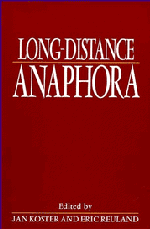Book contents
- Frontmatter
- Contents
- List of contributors
- Preface
- 1 Long-distance anaphora: an overview
- 2 Containment and connectedness anaphors
- 3 Long-distance reflexives and the typology of NPs
- 4 Contextual determination of the anaphor/pronominal distinction
- 5 On the interaction between antecedent-government and binding: the case of long-distance reflexivization
- 6 Binding in Polish
- 7 Anaphors in binary trees: an analysis of Czech reflexives
- 8 Latin long-distance anaphora
- 9 Prepositions, binding and θ-marking
- 10 Locality, parameters and some issues in Italian syntax
- 11 Long-distance binding in Finnish
- 12 The primacy condition of anaphora and pronominal variable binding
- 13 The local nature of the long-distance reflexive in Chinese
- 14 Anaphors and logophors: an argument structure perspective
- References
- Index
1 - Long-distance anaphora: an overview
Published online by Cambridge University Press: 01 June 2011
- Frontmatter
- Contents
- List of contributors
- Preface
- 1 Long-distance anaphora: an overview
- 2 Containment and connectedness anaphors
- 3 Long-distance reflexives and the typology of NPs
- 4 Contextual determination of the anaphor/pronominal distinction
- 5 On the interaction between antecedent-government and binding: the case of long-distance reflexivization
- 6 Binding in Polish
- 7 Anaphors in binary trees: an analysis of Czech reflexives
- 8 Latin long-distance anaphora
- 9 Prepositions, binding and θ-marking
- 10 Locality, parameters and some issues in Italian syntax
- 11 Long-distance binding in Finnish
- 12 The primacy condition of anaphora and pronominal variable binding
- 13 The local nature of the long-distance reflexive in Chinese
- 14 Anaphors and logophors: an argument structure perspective
- References
- Index
Summary
Introduction
One of the major foci of linguistic research during the last decade has been the development of a theory of binding. Despite a reasonable amount of consensus on major issues, there are a number of persistent anomalies. Especially, an integrated view of so-called long-distance anaphors is lacking. The present book sets out to contribute to the development of such a view. In the individual chapters a number of important issues in the theory of local and long-distance anaphors are analysed. The purpose of this overview is to summarize and interpret the results. In section 2 we provide the necessary background. Section 3 summarizes the individual contributions and puts them into context. Section 4 presents an overview of the facts reported. Section 5 discusses a major result of the book as a whole: the existence of just two main classes of A-anaphors.
Binding theory and its parameters
The starting point of most current discussions of anaphora is the binding theory (BT) developed by Chomsky in a series of works from 1973 on. (1) gives the formulation in Chomsky (1981).
A. An anaphor is bound in its governing category.
B. A pronominal is free in its governing category.
C. An R-expression is free.
The definition of ‘governing category’ is given in (2).
(2) b is a governing category for a if and only if b is the minimal category containing a, a governor of a, and a SUBJECT (accessible to a).
- Type
- Chapter
- Information
- Long Distance Anaphora , pp. 1 - 26Publisher: Cambridge University PressPrint publication year: 1991
- 27
- Cited by

